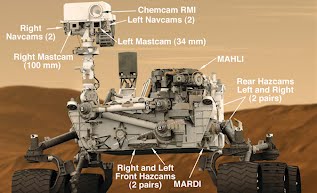by: Nicole Willett
The issue of water on Mars has been debated for over a century. The observations of Giovanni Schiaparelli in approximately 1877 started the frenzy over water on Mars. When Schiaparelli observed what he thought were channels on Mars he called them canali which means channels. When his findings were published, the term was misinterpreted as canals. There is a distinct difference between channels and canals. A channel is a naturally occurring groove in the ground where water or some other fluid has eroded the soil away to make a riverbed. A canal is thought to be something made by people or other beings, for water to flow through. So the speculation of water on the Red Planet began.
Percival Lowell built a telescope specifically to observe Mars. He was intrigued with the findings of Schiaparelli. He studied the planet for 15 years with his new telescope in Flagstaff, Az. His sketches show many features that at the time were considered to be evidence of intelligent beings on Mars. Many people disagreed with Lowell’s observations and he was ostracized by some. As technology advanced, we discovered that some of the geological features were present, but not in the exact state recorded by Lowell. The Mariner 4 and 9 spacecraft proved that the drawings Lowell made were not accurate. However, the spacecraft proved that there were many channels that once held liquid that flowed over the surface of Mars.
 Each spacecraft that visited the Red Planet gave more and more clues to its watery past.
Each spacecraft that visited the Red Planet gave more and more clues to its watery past.
Today NASA released an article titled, Meltwater on Mars Could Sustain Life on their Astrobio.net website. Click the link for the full article: http://www.astrobio.net/pressrelease/5150/meltwater-on-mars-could-sustain-life. Researchers from the University of Gothenburg, Sweden have compared satellite images of areas on Mars and Earth. The areas studied show correlations between the two planets where scientists believe there have been repeated freeze and thaw cycles. While comparing satellite images and doing field research on Earth, the researchers believe that some of the gullies on Mars were formed by melting snow and flowing water.
We know the surface temperature at the Gale Crater was 40o F when the Curiosity Rover took its first measurements. That is above the freezing point of water. The pressure on Mars would cause pure water to evaporate very quickly. We also know that the soil on Mars is full of many salts and minerals that when present in water will allow it to remain in a liquid state at the surface.
On Earth there are organisms that survive under extreme circumstances, with no water for decades or even centuries. These organisms lie dormant or in a state of extreme metabolic stasis for very long periods of time until the proper environmental conditions become available for normal metabolism and reproduction. It is known that the requirements for life are available on Mars. These conditions may seem foreign to some, but to astrobiologists, the conditions are no different than many places on Earth. So to paraphrase Dr. Chris McKay, if we do not find life on Mars, where the conditions are present, then I will be surprised if we find it anywhere else.














